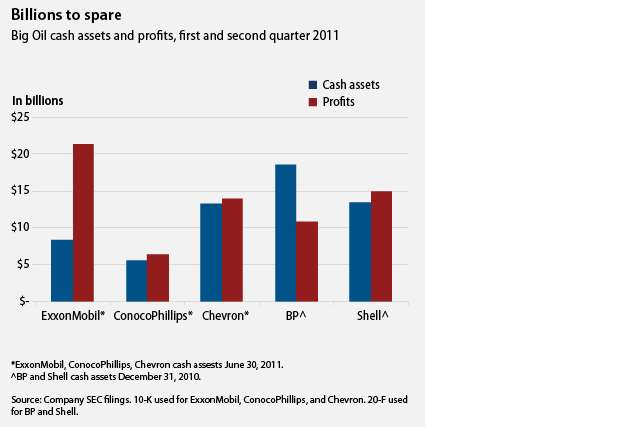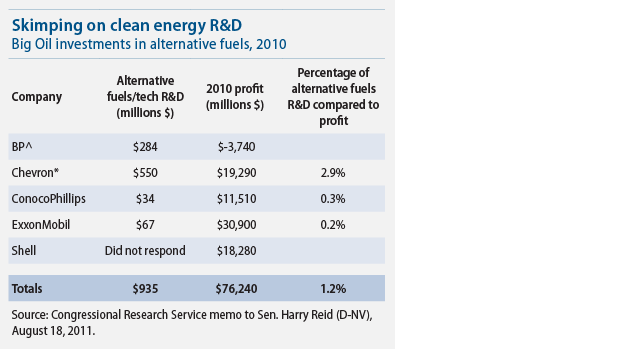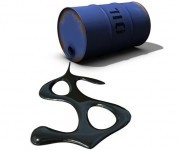Cross-posted from the Center for American Progress. This post was coauthored by Valeri Vasquez, special assistant for energy policy at the Center for American Progress.
On Sept. 19, President Barack Obama announced his plan to reduce the deficit by $4 trillion over the next 12 years, including raising $1.5 trillion by closing special interest loopholes and other revenue raisers. This includes eliminating $41 billion in tax loopholes for the oil and gas industry [PDF, p. 63] over the next decade.
Big Oil is predictably opposed to losing its unnecessary tax breaks. The American Petroleum Institute, or API, the oil industry’s lobbying muscle, quickly claimed that “the administration plan would hurt jobs and investment.”
But this claim ignores the fact that the big five oil companies — BP, Chevron, ConocoPhilips, ExxonMobil, and Shell — have ample financial resources that dwarf the value of these tax breaks. These companies enjoy billions in cash reserves, made nearly $1 trillion in profits over the past decade, and at least one company (ExxonMobil) pays a lower effective tax rate than the average American family.
In other words, Big Oil can readily afford to contribute its “fair share” to reduce America’s debt.
A Federal Reserve report released this month documented the massive cash reserves held by American corporations. The Wall Street Journal reported:
Corporations have a higher share of cash on their balance sheets than at any time in nearly half a century, as businesses build up buffers rather than invest in new plants or hiring.
Nonfinancial companies held more than $2 trillion in cash and other liquid assets at the end of June, the Federal Reserve reported Friday, up more than $88 billion from the end of March. Cash accounted for 7.1% of all company assets, everything from buildings to bonds, the highest level since 1963.
The big five oil companies are among those corporations that amassed huge cash reserves. In fact, a Center for American Progress (CAP) analysis of company Security and Exchange Commission filings determined that the three largest American oil companies — Chevron, ConocoPhillips, and ExxonMobil — had $27 billion in cash or equivalent assets as of midyear 2011.
BP and Shell, the two largest foreign oil companies that operate in the United States, had combined cash reserves of nearly $32 billion at the end of last year (the latest data available). Added together, these five companies are sitting on cash resources of $59 billion, which is 30 times more than the estimated $2 billion in annual tax breaks that these companies receive.

The past decade was very prosperous for the big five oil companies due in part to high oil prices, including the record of $147 per barrel in July 2008. A CAP assessment determined that these companies made more than $900 billion in profit from 2001 to 2010. High oil prices this year earned them a whopping $67 billion in six months. These funds come from the pockets of American drivers forced to pay up to $4 per gallon for gasoline.
At this rate, Big Oil could easily exceed $100 billion in profits for 2011. Why can’t these companies afford to forgo $2 billion annually in taxpayers’ money?
On Sept. 19, President Obama implored wealthy individuals and corporations to help reduce the deficit, too:
Those who have done well, including me, should pay our fair share in taxes to contribute to the nation that made our success possible. We shouldn’t get a better deal than ordinary families get.
Yet at least one oil company, ExxonMobil, has a much better deal than ordinary families. It made $310 billion in profits over the past decade and another $21 billion in the first six months of 2011 alone. A Washington Post expose based on a CAP analysis, however, found that ExxonMobil had a lower effective tax rate than the typical middle-class family. ExxonMobil’s effective tax rate was 18 percent while average households pay 21 percent — 15 percent more than Exxon’s tax rate.
The Post determined that these tax loopholes “have helped make the oil industry one of the most profitable, when measured by cash flow and return on investment.”
API claims that Big Oil needs the tax loopholes to create jobs and make investments. But are the big five oil companies investing these funds in job creation or clean energy? The evidence says no.
“Profits and Pink Slips: How Big Oil and Gas Companies Are Not Creating U.S. Jobs or Paying Their Fair Share,” by the House Natural Resources Committee Democrats, determined [PDF] that Big Oil companies shed jobs over the last five years:
Despite generating $546 billion in profits between 2005 and 2010, ExxonMobil, Chevron, Shell, and BP combined to reduce their U.S. workforce by 11,200 employees over that time.
Just in 2010 alone, the big 5 oil companies reduced their global workforce by a combined 4,400 employees, while making a combined $73 billion in profits.
So if the big five companies aren’t hiring additional workers, are they investing in research and development? The Congressional Research Service (CRS) found that the companies invested relatively little in overall research and development: “Total R&D expenditure of the five [largest oil] firms in 2010 was $3.6 billion.” This was just 4.7 percent of their $76 billion in profits.
The CRS noted that “it is difficult to determine how much of the R&D spending … was spent on green R&D projects from data published by the oil majors themselves.” These investments would provide financial and energy security for Americans in the grip of the volatile global petroleum market and help mitigate the climate change driven by fossil fuel consumption. But it did compile the information on alternative fuels and cleantech investments provided by the big five companies to the Senate Finance Committee for a May hearing on Oil and Gas Tax Incentives and Rising Energy Prices. It appears that these companies spent a miserly 1.2 percent on alternative fuels and cleantech research in 2010:

This finding confirms a 2009 CAP analysis that determined these companies devoted a mere 4 percent of their collective 2008 earnings
to cleantech research and development. That year was their second-highest profit level.
Clearly the big five oil companies are not investing their huge profits in hiring workers or conducting alternative fuels research and development. Instead, many of these companies use their profits to buy back their own stock, an action that enriches their board of directors, senior executives, and shareholders.
These companies spent slightly more than one-quarter of their profits on stock buybacks in the first half of 2011. This dwarfs the previous year’s investment in research and development (see attached Excel spreadsheet). Yet the big five oil companies still claw to keep $20 billion worth of tax breaks.
President Obama has posed stark choices to reduce the federal budget deficit:
Either we ask the wealthiest Americans to pay their fair share in taxes, or we’re going to have to ask seniors to pay more for Medicare. We can’t afford to do both.
Either we gut education and medical research, or we’ve got to reform the tax code so that the most profitable corporations have to give up tax loopholes that other companies don’t get. We can’t afford to do both.
He proposed that the big five oil companies contribute $20 billion over a decade since these extraordinarily rich companies hold billions of dollars in cash reserves, made nearly $1 trillion in profits, and the biggest of them pays a lower effective federal tax rate than the average American family.
It’s up to Congress to support seniors, students, workers, and middle-class families instead of genuflecting to Big Oil companies and their lobbyists once again.


